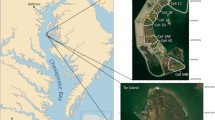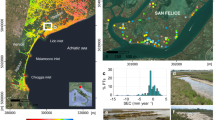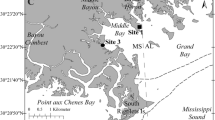Abstract
Currently, the largest tidal wetlands restoration project on the US Pacific Coast is being planned and implemented in southern San Francisco Bay; however, knowledge of baseline conditions of salt marsh extent in the region prior to European settlement is limited. Here, analysis of 24 sediment cores collected from ten intact southern San Francisco Bay tidal marshes were used to reconstruct spatio-temporal patterns of marsh expansion to provide historic context for current restoration efforts. A process-based marsh elevation simulation model was used to identify interactions between sediment supply, sea-level rise, and marsh formation rates. A distinct age gradient was found: expansion of marshes in the central portion of southern San Francisco Bay dated to 500 to 1500 calendar years before present, while expansion of marshes in southernmost San Francisco Bay dated to 200 to 700 calendar years before present. Thus, much of the tidal marsh area mapped by US Coast Survey during the 1853–1857 period were in fact not primeval tidal marshes that had persisted for millennia but were recently formed landscapes. Marsh expansion increased during the Little Ice Age, when freshwater inflow and sediment influx were higher than during the previous millennium, and also during settlement, when land use changes, such as introduction of livestock, increased watershed erosion, and sediment delivery.





Similar content being viewed by others
References
Anderson, R.S. 2005. Contrasting vegetation and fire histories on the Point Reyes Peninsula during the pre-settlement and historic periods. Final report to the Point Reyes National Seashore. Flagstaff, Arizona: Northern Arizona University.
Anderson, R.S., H.W. Borns, D.C. Smith, and C. Race. 1992. Implications of rapid sediment accumulation in a small New-England salt marsh. Canadian Journal of Earth Sciences 29: 2013–2017.
Atwater, B.F. 1979. Ancient processes at the site of southern San Francisco Bay: movement of the crust and changes in sea level. In San Francisco Bay: the urbanized estuary, ed. T.J. Conomos, 31–45. San Francisco, California: The American Association for the Advancement of Science.
Bernhardt, C.E., and D.A. Willard. 2009. Response of the Everglades ridge and slough landscape to climate variability and 20th-century water management. Ecological Applications 19: 1723–1738.
Biondi, F., C. Isaacs, M.K. Hughes, D.R. Cayan, and W.H. Berger. 2000. The near-1600 dry/wet knock-out: linking terrestrial and near-shore ecosystems. In Proceedings of the 24th Annual Climate Diagnostics and Prediction Workshop, Springfield, Virginia: National Technical Information Service, US Department of Commerce. pp. 76–79
Boyle, J.G., A.J. Plater, C. Mayers, S.D. Turner, R.W. Stroud, and J.E. Weber. 2011. Land use, soil erosion, and sediment yield at Pinto Lake, California: comparison of a simplified USLE model with the lake sediment record. Journal of Paleolimnology 45: 199–212.
Broek, J.O.M. 1932. The Santa Clara Valley, California: a study in landscape changes. Utrecht, The Netherlands, N.V. A. Oosthoek’s Uitgevers-Mij.
Bromirski, P.D., A.J. Miller, R.E. Flick, and G. Auad. 2011. Dynamical suppression of sea level rise along the Pacific coast of North America: indications for imminent acceleration. Journal of Geophysical Research 116: C07005.
Brush, G.S. 1989. Rates and patterns of estuarine sediment accumulation. Limnology and Oceanography 34: 1235–1246.
Byrne, R., B.L. Ingram, S. Starratt, F. Malamud-Roam, J.N. Collins, and M.E. Conrad. 2001. Carbon-isotope, diatom, and pollen evidence for Late Holocene salinity change in a brackish marsh in the San Francisco Estuary. Quaternary Research 55: 66–76.
California Department of Fish and Game (CDFG). 2010. Lower Eel River watershed assessment. Sacramento, California: California Department of Fish and Game, Coastal Watershed Planning and Assessment Program. http://coastalwatersheds.ca.gov/LinkClick.aspx?fileticket=IqyBZ%2BNXqhg%3D&tabid=669&mid=1186
Cappiella, K., C. Malzone, R. Smith, and B. Jaffe. 1999. Sedimentation and bathymetry changes in Suisun Bay: 1867–1900. USGS Open File Report 99-563. US Geological Survey, Santa Cruz, California. http://geopubs.wr.usgs.gov/open-file/of99-563/
Clark, P.U., A.M. McCabe, A.C. Mix, and A.J. Weaver. 2004. Rapid rise of sea level 19,000 years ago and its global implications. Science 304: 1141–1144.
Constantine, J.A., G.B. Pasternack, and M.L. Johnson. 2005. Logging effects on sediment flux observed in a pollen-based record of overbank deposition in a northern California catchment. Earth Surface Processes and Landforms 30: 813–821.
Davis, O.K. 1992. Rapid climatic change in coastal southern California inferred from pollen analysis of San Joaquin Marsh. Quaternary Research 37: 89–100.
Dean, W.E. 1974. Determination of carbonate and organic matter in calcareous sedimentary rocks by loss on ignition: comparison with other methods. Journal of Sedimentary Petrology 44: 242–248.
Drexler, J.Z., C.S. de Fontaine, and T.A. Brown. 2009. Peat accretion histories during the past 6,000 years in marshes of the Sacramento-San Joaquin Delta, CA, USA. Estuaries and Coasts 32: 871–892.
Duffy, W., D.F. Belknap, and J.T. Kelley. 1989. Morphology and stratigraphy of small barrier-lagoon systems in Maine. Marine Geology 88: 243–262.
Fairbanks, R.G. 1989. A 17,000-year glacio-eustatic sea level record: influence of glacial melting rates on the Younger Dryas event and deep-ocean circulation. Nature 342: 637–642.
Friedly, M. 2000. This brief Eden: a history of landscape change in California’s Santa Clara Vally. Ph.D. dissertation. Durham, North Carolina: Duke University.
Gehrels, W.R, and S.P. Leatherman, S.P. 1989. Sea-level rise - animator and terminator of coastal marshes: an annotated bibliography on US coastal marshes and sea-level rise. Public Administration Series Bibliography P 2634. Monticello, Illinois: Vance Bibliographies.
Gilbert, G.K. 1917. Hydraullic-mining debris in the Sierra Nevada. USGS Professional Paper 105. Washington D.C.: U.S. Geological Survey.
Goals Project. 1999. Baylands ecosystem habitat goals. A report of habitat recommendations prepared by the San Francisco Bay Area Wetlands Ecosystems Goals Project. San Francisco and Oakland, CA: Joint publication of the US EPA and SF Bay Regional Water Quality Control Board.
Goman, M., and L. Wells. 2000. Trends in river flow affecting the northeastern reach of the San Francisoc Bay Estuary over the past 7000 years. Quaternary Research 54: 206–217.
Goman, M., F. Malamud-Roam, and B.L. Ingram. 2008. Holocene environmental history and evolution of a tidal marsh in San Francisco Bay, California. Journal of Coastal Research 24: 1126–1137.
Graham, N.E., M.K. Hughes, C.M. Ammann, K.M. Cobb, M.P. Hoerling, D.J. Kennett, J.P. Kennett, B. Rein, L. Stott, P.E. Wigand, and T.Y. Xu. 2007. Tropical Pacific—mid-latitude teleconnections in Medieval Times. Climatic Change 83: 241–285.
Grossinger, R., and C. Reed. 2001. Resurvey of San Pablo Bay. Bay nature 1. http://baynature.org/articles/resurvey-of-san-pablo-bay/
Hilgartner, W.B., and G.S. Brush. 2006. Prehistoric habitat stability and post-settlement habitat change in a Chesapeake Bay freshwater tidal wetland, USA. The Holocene 16: 479–494.
Hughes, M.K., and H.F. Diaz. 2008. Climatic variability and change in the drylands of Western North America. Global and Planetary Change 64: 111–118.
Jackson, R.H., and E.D. Castillo. 1995. Indians, Franciscans, and Spanish colonization: the impact of the Mission system on California Indians, 1st edition. Albuquerque: University of New Mexico Press.
Jennings, S.C., R.W.G. Carter, and J.D. Orford. 1993. Late Holocene salt-marsh development under a regime of rapid relative sea leve rise – Chezetcook inlet, Nova Scotia – implications for the interpretation of paleomarsh sequences. Canadian Journal of Earth Science 30: 1374–1384.
Keene, H.W. 1971. Postglacial submergence and salt marsh evolution in New Hampshire. Maritime Sediments 7: 64–68.
Kennedy, J.C.G. 1864. Agriculture of the United States in 1860; compiled from the original returns of the eighth census. Washington D.C.: Government Printing Office.
Kennett, D.J., and J.P. Kennett. 2000. Competitive and cooperative responses to climatic instability in Southern California. American Antiquity 65: 379–395.
Kirby, M.E., C.J. Poulsen, S.P. Lund, W.P. Patterson, L. Reidy, and D.E. Hammond. 2004. Late Holocene lake level dynamics inferred from magnetic susceptibility and stable oxygen isotope data: Lake Elsinore, southern California. Journal of Paleolimnology 31: 275–293.
Kirwan, M.L., A.B. Murray, J.P. Donnelly, and D.R. Corbett. 2011. Rapid wetland expansion during European settlement and its implication for marsh survival under modern sediment delivery rates. Geology 39: 507–510.
Krone, R.B. 1987. A method for simulating historic marsh elevations. In Coastal sediments 1987, ed. N.C. Kraus, 316–323. New York: American Society of Civil Engineers.
Lambeck, K., and J. Chappell. 2001. Sea level change through the last glacial cycle. Science 292: 679–686.
Malamud-Roam, F., and B.L. Ingram. 2004. Late Holocene δ13C and pollen records of paleosalinity from tidal marshes in the San Francisco Bay Estuary, California. Quaternary Research 62: 134–145.
Malamud-Roam, F.P., B.L. Ingram, M. Hughes, and J.L. Florsheim. 2006a. Holocene paleoclimate records from a large California estuarine system and its watershed region: linking watershed climate and bay conditions. Quaternary Science Reviews 25: 1570–1598.
Malamud-Roam, K.P.F.P., E.B. Malamud-Roam, J.N.C. Watson, and B.L. Ingram. 2006b. The quaternary geography and biogeography of tidal saltmarshes. Studies in Avian Biology 32: 11–31.
May, M.D. 1999. Vegetation and salinity changes over the last 2000 years at two islands in the northern San Francisco Estuary, California. M.A. thesis, University of California, Berkeley, California.
McGann, M. 2008. High-resolution foraminiferal, isotopic, and trace element records from Holocene estuarine depositions of San Francisco Bay, California. Journal of Coastal Research 24: 1092–1109.
McKee, L.J., N.K. Ganju, and D.H. Scoellhamer. 2006. Estimates of suspended sediment entering San Francisco Bay from the Sacramento and San Joaquin Delta, San Francisco Bay, California. Journal of Hydrology 323: 335–352.
Mitchell-Tapping, H.J., A.M. Mitchell-Tapping, T.J. Lee, and C.R. Williams. 1996. Core evidence of sea level high stands in Southwestern Florida during the last 5,000 years. Gulf Coast Association of Geological Studies Transactions 46: 47–53.
Mohr, J.A., C. Whitlock, and C.N. Skinner. 2000. Postglacial vegetation and fire history, eastern Klamath Mountains, California, USA. The Holocene 10: 587–601.
Nichols, F.H., J.E. Coern, S.N. Luoma, and D.H. Peterson. 1986. The modification of an estuary. Science 231: 525–528.
Orson, R.A., R.S. Warren, and W.A. Niering. 1987. Development of a tidal marsh in a New England river valley. Estuaries 10: 20–27.
Palacios-Fest, M.R., J.A. Homburg, E.C. Brevik, A.R. Orme, O.K. Davis, and S.D. Shelley. 2006. Paleoecología del Cuaternario Tardío en la Laguna de Ballona en el sur de California (Late Quaternary palaeoecology of Ballona Lagoon in southern California). Ciencias Marinas 32: 485–504.
Pasternack, G.B., G.S. Brush, and W.B. Hilgartner. 2001. Impact of historic land-use change on sediment delivery to a Chesapeake Bay subestuarine delta. Earth Surface Processes and Landforms 26: 409–427.
Pederson, D.C., D.M. Peteet, D. Kurdyla, and T. Guilderson. 2005. Medieval Warming, Little Ice Age, and European impact on the environment during the last millennium in the lower Hudson Valley, New York, USA. Quaternary Research 63: 238–249.
Peteet, D.M., D.C. Pederson, D. Kurdyla, and T. Guilderson. 2007. Hudson River paleoecology from marshes: environmental change and its implications for fisheries. In Hudson River Fishes and Their Environment, eds. J.R. Waldman, K.E. Limburg, and D. Strayer, 112–128. American Fisheries Society
Peterson, D.H., D. Cayan, J. DiLeo, M. Noble, and M. Dettinger. 1995. The role of climate in estuarine variability. American Scientist 83: 58–67.
Plater, A.J., J.F. Boyle, C. Mayers, S.D. Turner, and R.W. Stroud. 2006. Climate and human impact on lowland lake sedimentation in Central Coastal California: the record from ca. 650 a.d. to the present. Regional Environmental Change 6: 71–85.
Poland, J.F. 1985. Guidebook to studies in land subsidence due to groundwater withdrawal. Studies and Reports in Hydrology, No. 40. Paris: UNESCO.
Redfield, A.C. 1972. Development of a New England salt marsh. Ecological Monographs 42: 201–237.
Redfield, A.C., and M. Rubin. 1962. The age of salt marsh peat and its relation to recent changes in sea-level at Barnstable, Massachusetts. Proceedings of the National Academy of Science 48: 1728–35.
Reed, D.J. 1990. The impact of sea-level rise on coastal marshes. Progress in Physical Geography 14: 465–481.
Reidy, L.M. 2001 Evidence of environmental change over the last 2000 years at Mountain Lake in the Northern San Francisco Peninsula, California. M.A. thesis, University of California, Berkeley, California.
Reimer, P.J., M.G.L. Baillie, E. Bard, A. Bayliss, J.W. Beck, C.J.H. Bertrand, P.G. Blackwell, C.E. Buck, G.S. Burr, K.B. Cutler, P.E. Damon, R.L. Edwards, R.G. Fairbanks, M. Friedrich, T.P. Guilderson, A.G. Hogg, K.A. Hughen, B. Kromer, F.G. McCormac, S.W. Manning, C.B. Ramsey, R.W. Reimer, S. Remmele, J.R. Southon, M. Stuiver, S. Talamo, F.W. Taylor, J. van der Plicht, and C.E. Weyhenmeyer. 2004. IntCal04 terrestrial radiocarbon age calibration, 26–0 ka BP. Radiocarbon 46: 1029–1058.
San Francisco Estuary Institute (SFEI). 2006. US Coast Service maps of San Francisco Bay. Oakland, CA: San Francisco Estuary Institute. http://maps.sfei.org/tSheets/viewer.htm. Accessed 17 Aug 2006.
Schimmelmann, A., M. Zhao, C.C. Harvey, and C.B. Lange. 1998. A large California flood and correlative global climatic events 400 years ago. Quaternary Research 49: 51–61.
Schwartz, D.L., H.T. Mullins, and D.F. Belknap. 1986. Holocene geologic history of a transform margin estuary: Elkhorn Slough, Central California. Estuarine, Coastal and Shelf Science 22: 285–302.
Stuiver, M., P. J. Reimer, and R. W. Reimer. 2005. CALIB 5.0. WWW program and documentation. Seattle, Washington: M. Stuiver and P. Reimer. http://calib.qub.ac.uk/calib/. Accessed 16 Feb 2008.
Tweel, A.W., and R.E. Turner. 2012. Watershed land use and river engineering drive wetland formation and loss in the Mississippi River birdfoot delta. Limnology and Oceanography 12: 18–28.
Uncles, R.J., and D.H. Peterson. 1996. The long-term salinity field in San Francisco Bay. Continental Shelf Research 16: 2005–2039.
US Department of Agriculture. 1994. 1992 Census of Agriculture. Washington D.C.: Bureau of the Census.
US Department of Agriculture. 1999. 1997 Census of Agriculture. Washington D.C.: US Department of Agriculture, National Agricultural Statistics Service.
US Department of Agriculture. 2004. 2002 Census of Agriculture. Washington D.C.: US Department of Agriculture, National Agricultural Statistics Service.
US Department of Agriculture. 2009. 2007 Census of Agriculture. Washington D.C.: US Department of Agriculture, National Agricultural Statistics Service.
US Department of Commerce. 1922. 1920 Census of Agriculture. Washington D.C.: US Government Printing Office.
US Department of Commerce. 1932. 1930 Census of Agriculture. Washington D.C.: US Government Printing Office.
US Department of Commerce. 1942. 1940 Census of Agriculture. Washington D.C.: US Government Printing Office.
US Department of Commerce and Labor. 1902. 1900 Census of Agriculture. Washington D.C.: US Government Printing Office.
US Department of Commerce and Labor. 1913. 1910 Census of Agriculture. Washington D.C.: US Government Printing Office.
US Department of the Interior. 1882. 1880 Census of Agriculture. Washington D.C.: US Government Printing Office.
US Department of the Interior. 1895. 1890 Census of Agriculture. Washington D.C.: US Government Printing Office.
Walker, F.A. 1872. The statistics of the wealth and industry of the United States.Washington D.C.: Government Printing Office.
Watson, E.B., 2008. Marsh expansion at Calaveras Point Marsh, South San Francisco Bay, California. Estuarine, Coastal and Shelf Science 78: 593–602.
Watson, E.B., and R. Byrne. 2009. Abundance and diversity of tidal marsh plants along the salinity gradient of the San Francisco Estuary: implications for global change ecology. Plant Ecology 205: 113–128.
Wigand, P.E. 1987. Diamond Pond, Harney County, Oregon—vegetation history and water table in the eastern Oregon desert. Great Basin Naturalist 47: 427–258.
Willard, D.A., C.E. Bernhardt, C.W. Holmes, B. Landacre, and M. Marot. 2006. Response of Everglades tree islands to environmental change. Ecological Monographs 76: 565–583.
Willis, J.K., and J.A. Church. 2012. Regional sea-level projection. Science 336: 550–551.
Wright, S., and D.H. Schoellhamer. 2004. Trends in the sediment yield of the Sacramento River, California 1957–2001. San Francisco Estuary and Watershed Science 2.
Zedler, J.B., C.S. Nordby, and B.E. Kus. 1992. The ecology of Tijuana Estuary, California: a National Estuarine Research Reserve. Washington, DC: National Oceanic and Atmospheric Administration.
Zedler, J.B., J.C. Callaway, J.S. Desmond, G. Vivian-Smith, G.D. Williams, G. Sulivan, A.E. Brewster, and B.K. Bradshaw. 1999. Californian salt-marsh vegetation: an improved model of spatial pattern. Ecosystems 2: 19–35.
Acknowledgements
Thanks to Josh Borokowski, Lorraine Cassazza, Drisanna Watson, Ben Moorman, Kelly Lindblom, Julio Angulo, and Don Watson for assistance with core collection. Funding for radiocarbon dating was provided by a Stahl Grant from the Archaeological Research Facility, U.C. Berkeley, and from a Mia Tegner grant from the Marine Conservation Biology Institute. We thank Andrew Gray, David Rice, Chuck Striplen, and Noah Knowles for helpful discussions, and Brian Atwater for constructive suggestions. Help with graphics was provided by Patricia DeCastro. Mention of trade names or commercial products does not constitute endorsement or recommendation for use. This is contribution number AED-11-088 of the Atlantic Ecology Division, National Health and Environmental Effects Research Laboratory, Office of Research and Development, U. S. Environmental Protection Agency. Although the information in this document has been funded wholly (or in part) by the US Environmental Protection Agency, it does not necessarily reflect the views of the Agency and no official endorsement should be inferred.
Author information
Authors and Affiliations
Corresponding author
Rights and permissions
About this article
Cite this article
Watson, E.B., Byrne, R. Late Holocene Marsh Expansion in Southern San Francisco Bay, California. Estuaries and Coasts 36, 643–653 (2013). https://doi.org/10.1007/s12237-013-9598-z
Received:
Revised:
Accepted:
Published:
Issue Date:
DOI: https://doi.org/10.1007/s12237-013-9598-z




